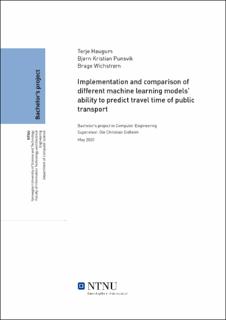| dc.contributor.advisor | Eidheim, Ole Christian | |
| dc.contributor.author | Haugum, Terje | |
| dc.contributor.author | Punsvik, Bjørn Kristian | |
| dc.contributor.author | Wichstrøm, Brage | |
| dc.date.accessioned | 2020-08-16T16:02:25Z | |
| dc.date.available | 2020-08-16T16:02:25Z | |
| dc.date.issued | 2020 | |
| dc.identifier.uri | https://hdl.handle.net/11250/2672194 | |
| dc.description.abstract | I dette studiet ønsker vi å bruke maskinlæringsmodeller på sanntidsdata for å prediktere ankomsttidene av busser. Den overordnede oppgaven er å prediktere forandringer fra de planlagte busstidene som eksisterer i Oslo ved bruk av maskinlæringsmodeller. Å prediktere ankomsttider er et viktig segment innen Intelligent Transport System (ITS), og det er en kompleks oppgave innen det urbane trafikkmiljøet ettersom det er mange uforutsette hendelser som oppstår i trafikken. Vårt hovedmål er å sammenligne et sett av alternative maskinlæringsmodeller med en enkel historisk modell for å identifisere den beste modellen for å prediktere ankomsttider i et urbant område. Vi har gjennomført et litteratursøk på tidligere arbeid gjort på dette feltet, og identifisert de vanligste modellene som viste gode resultater i motsetning til de eksisterende systemene. Artificial Neural Network (ANN) er den mest brukte modellen, men Support Vector Regression(SVR) og Long-Short Term Memory model (LSTM) har også vist til gode resultater for å prediktere ankomsttider til busser. Litteraturlisten som beskriver de ulike modellene gitt over i tillegg til andre modeller som vi ser relevante, blir detaljert beskrevet. I kapittelet etter, beskriver vi hvor vi hentet våre dataset som modellene våre bruker, i tillegg blir modellutviklingen og data manipulasjonen beskrevet i detalj. Ut fra resultatene gav LSTM de beste prediksjonene, mens ANN modellen var mest økonomisk med tanke på tiden det tok å trene den i tillegg til hvor godt den predikterte ankomsttidene. | |
| dc.description.abstract | In this paper we aim to utilize machine learning methods on open near real-time data to predict the arrival times of buses. The overarching task is to predict anomalies from the planned bus schedule existing in Oslo using machine learning models. Predicting arrival times is an important segment within Intelligent Transport Systems (ITS), and a daunting task in urban areas due to excessive traffic anomalies. Our main focus of inquiry is to compare a set of alternative implemented models with a simple historical model in order to identify an optimal model for predicting arrival times of buses in urban areas. We conducted a literature search on previous work on this issue, and identified the most typical models that tended to outperform the current real-world applications. Artificial neural networks(ANN) is the most frequently used model. However, Support Vector Regression(SVR) and Long-Short-Term-Memory(LSTM) models have also proven to perform well on finding correct arrival times. The literature regarding artificial models and other models considered to be relevant to the issue are explained in detail. In the section thereafter we detail where we received the data used in our models. Moreover, how we implemented our purposed models and how we sanitized the received data with data-conversions and interpolations are presented in the same section. We found LSTM to outperform the other models in regards to accuracy while ANN proved to be the most economical of the investigated models considering both time to train and accuracy. | en |
| dc.publisher | NTNU | |
| dc.title | Implementation and comparison of different machine learning models' ability to predict travel time of public transport | |
| dc.type | Bachelor thesis | |
